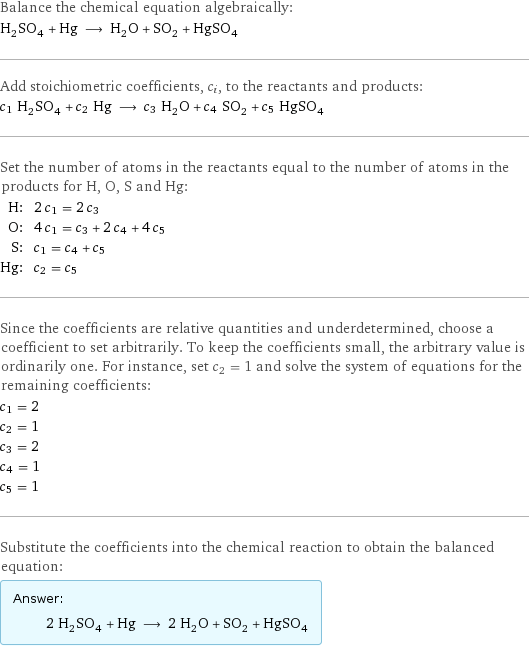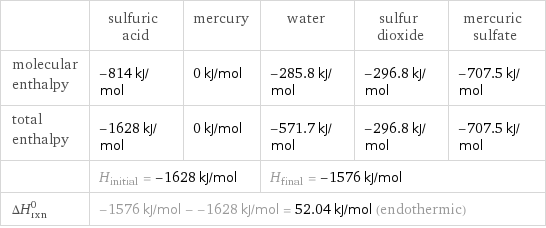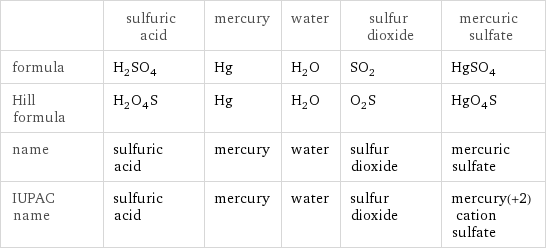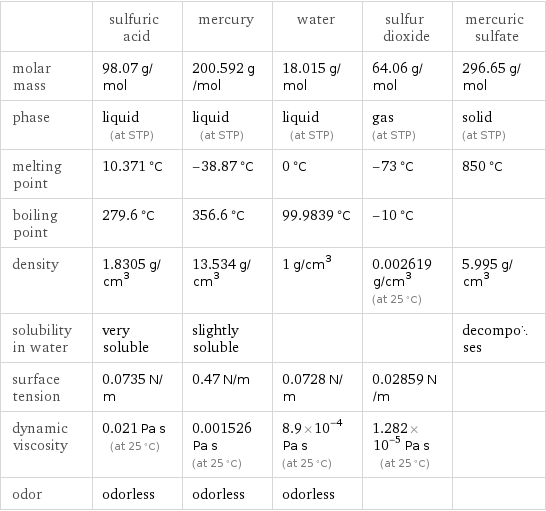Input interpretation

H_2SO_4 (sulfuric acid) + Hg (mercury) ⟶ H_2O (water) + SO_2 (sulfur dioxide) + HgSO_4 (mercuric sulfate)
Balanced equation

Balance the chemical equation algebraically: H_2SO_4 + Hg ⟶ H_2O + SO_2 + HgSO_4 Add stoichiometric coefficients, c_i, to the reactants and products: c_1 H_2SO_4 + c_2 Hg ⟶ c_3 H_2O + c_4 SO_2 + c_5 HgSO_4 Set the number of atoms in the reactants equal to the number of atoms in the products for H, O, S and Hg: H: | 2 c_1 = 2 c_3 O: | 4 c_1 = c_3 + 2 c_4 + 4 c_5 S: | c_1 = c_4 + c_5 Hg: | c_2 = c_5 Since the coefficients are relative quantities and underdetermined, choose a coefficient to set arbitrarily. To keep the coefficients small, the arbitrary value is ordinarily one. For instance, set c_2 = 1 and solve the system of equations for the remaining coefficients: c_1 = 2 c_2 = 1 c_3 = 2 c_4 = 1 c_5 = 1 Substitute the coefficients into the chemical reaction to obtain the balanced equation: Answer: | | 2 H_2SO_4 + Hg ⟶ 2 H_2O + SO_2 + HgSO_4
Structures

+ ⟶ + +
Names

sulfuric acid + mercury ⟶ water + sulfur dioxide + mercuric sulfate
Reaction thermodynamics
Enthalpy

| sulfuric acid | mercury | water | sulfur dioxide | mercuric sulfate molecular enthalpy | -814 kJ/mol | 0 kJ/mol | -285.8 kJ/mol | -296.8 kJ/mol | -707.5 kJ/mol total enthalpy | -1628 kJ/mol | 0 kJ/mol | -571.7 kJ/mol | -296.8 kJ/mol | -707.5 kJ/mol | H_initial = -1628 kJ/mol | | H_final = -1576 kJ/mol | | ΔH_rxn^0 | -1576 kJ/mol - -1628 kJ/mol = 52.04 kJ/mol (endothermic) | | | |
Equilibrium constant
![Construct the equilibrium constant, K, expression for: H_2SO_4 + Hg ⟶ H_2O + SO_2 + HgSO_4 Plan: • Balance the chemical equation. • Determine the stoichiometric numbers. • Assemble the activity expression for each chemical species. • Use the activity expressions to build the equilibrium constant expression. Write the balanced chemical equation: 2 H_2SO_4 + Hg ⟶ 2 H_2O + SO_2 + HgSO_4 Assign stoichiometric numbers, ν_i, using the stoichiometric coefficients, c_i, from the balanced chemical equation in the following manner: ν_i = -c_i for reactants and ν_i = c_i for products: chemical species | c_i | ν_i H_2SO_4 | 2 | -2 Hg | 1 | -1 H_2O | 2 | 2 SO_2 | 1 | 1 HgSO_4 | 1 | 1 Assemble the activity expressions accounting for the state of matter and ν_i: chemical species | c_i | ν_i | activity expression H_2SO_4 | 2 | -2 | ([H2SO4])^(-2) Hg | 1 | -1 | ([Hg])^(-1) H_2O | 2 | 2 | ([H2O])^2 SO_2 | 1 | 1 | [SO2] HgSO_4 | 1 | 1 | [HgSO4] The equilibrium constant symbol in the concentration basis is: K_c Mulitply the activity expressions to arrive at the K_c expression: Answer: | | K_c = ([H2SO4])^(-2) ([Hg])^(-1) ([H2O])^2 [SO2] [HgSO4] = (([H2O])^2 [SO2] [HgSO4])/(([H2SO4])^2 [Hg])](../image_source/4b876ff41ff675db44b99d252397b0f2.png)
Construct the equilibrium constant, K, expression for: H_2SO_4 + Hg ⟶ H_2O + SO_2 + HgSO_4 Plan: • Balance the chemical equation. • Determine the stoichiometric numbers. • Assemble the activity expression for each chemical species. • Use the activity expressions to build the equilibrium constant expression. Write the balanced chemical equation: 2 H_2SO_4 + Hg ⟶ 2 H_2O + SO_2 + HgSO_4 Assign stoichiometric numbers, ν_i, using the stoichiometric coefficients, c_i, from the balanced chemical equation in the following manner: ν_i = -c_i for reactants and ν_i = c_i for products: chemical species | c_i | ν_i H_2SO_4 | 2 | -2 Hg | 1 | -1 H_2O | 2 | 2 SO_2 | 1 | 1 HgSO_4 | 1 | 1 Assemble the activity expressions accounting for the state of matter and ν_i: chemical species | c_i | ν_i | activity expression H_2SO_4 | 2 | -2 | ([H2SO4])^(-2) Hg | 1 | -1 | ([Hg])^(-1) H_2O | 2 | 2 | ([H2O])^2 SO_2 | 1 | 1 | [SO2] HgSO_4 | 1 | 1 | [HgSO4] The equilibrium constant symbol in the concentration basis is: K_c Mulitply the activity expressions to arrive at the K_c expression: Answer: | | K_c = ([H2SO4])^(-2) ([Hg])^(-1) ([H2O])^2 [SO2] [HgSO4] = (([H2O])^2 [SO2] [HgSO4])/(([H2SO4])^2 [Hg])
Rate of reaction
![Construct the rate of reaction expression for: H_2SO_4 + Hg ⟶ H_2O + SO_2 + HgSO_4 Plan: • Balance the chemical equation. • Determine the stoichiometric numbers. • Assemble the rate term for each chemical species. • Write the rate of reaction expression. Write the balanced chemical equation: 2 H_2SO_4 + Hg ⟶ 2 H_2O + SO_2 + HgSO_4 Assign stoichiometric numbers, ν_i, using the stoichiometric coefficients, c_i, from the balanced chemical equation in the following manner: ν_i = -c_i for reactants and ν_i = c_i for products: chemical species | c_i | ν_i H_2SO_4 | 2 | -2 Hg | 1 | -1 H_2O | 2 | 2 SO_2 | 1 | 1 HgSO_4 | 1 | 1 The rate term for each chemical species, B_i, is 1/ν_i(Δ[B_i])/(Δt) where [B_i] is the amount concentration and t is time: chemical species | c_i | ν_i | rate term H_2SO_4 | 2 | -2 | -1/2 (Δ[H2SO4])/(Δt) Hg | 1 | -1 | -(Δ[Hg])/(Δt) H_2O | 2 | 2 | 1/2 (Δ[H2O])/(Δt) SO_2 | 1 | 1 | (Δ[SO2])/(Δt) HgSO_4 | 1 | 1 | (Δ[HgSO4])/(Δt) (for infinitesimal rate of change, replace Δ with d) Set the rate terms equal to each other to arrive at the rate expression: Answer: | | rate = -1/2 (Δ[H2SO4])/(Δt) = -(Δ[Hg])/(Δt) = 1/2 (Δ[H2O])/(Δt) = (Δ[SO2])/(Δt) = (Δ[HgSO4])/(Δt) (assuming constant volume and no accumulation of intermediates or side products)](../image_source/ba82ae9d5f4402fe712a89d2027bf80f.png)
Construct the rate of reaction expression for: H_2SO_4 + Hg ⟶ H_2O + SO_2 + HgSO_4 Plan: • Balance the chemical equation. • Determine the stoichiometric numbers. • Assemble the rate term for each chemical species. • Write the rate of reaction expression. Write the balanced chemical equation: 2 H_2SO_4 + Hg ⟶ 2 H_2O + SO_2 + HgSO_4 Assign stoichiometric numbers, ν_i, using the stoichiometric coefficients, c_i, from the balanced chemical equation in the following manner: ν_i = -c_i for reactants and ν_i = c_i for products: chemical species | c_i | ν_i H_2SO_4 | 2 | -2 Hg | 1 | -1 H_2O | 2 | 2 SO_2 | 1 | 1 HgSO_4 | 1 | 1 The rate term for each chemical species, B_i, is 1/ν_i(Δ[B_i])/(Δt) where [B_i] is the amount concentration and t is time: chemical species | c_i | ν_i | rate term H_2SO_4 | 2 | -2 | -1/2 (Δ[H2SO4])/(Δt) Hg | 1 | -1 | -(Δ[Hg])/(Δt) H_2O | 2 | 2 | 1/2 (Δ[H2O])/(Δt) SO_2 | 1 | 1 | (Δ[SO2])/(Δt) HgSO_4 | 1 | 1 | (Δ[HgSO4])/(Δt) (for infinitesimal rate of change, replace Δ with d) Set the rate terms equal to each other to arrive at the rate expression: Answer: | | rate = -1/2 (Δ[H2SO4])/(Δt) = -(Δ[Hg])/(Δt) = 1/2 (Δ[H2O])/(Δt) = (Δ[SO2])/(Δt) = (Δ[HgSO4])/(Δt) (assuming constant volume and no accumulation of intermediates or side products)
Chemical names and formulas

| sulfuric acid | mercury | water | sulfur dioxide | mercuric sulfate formula | H_2SO_4 | Hg | H_2O | SO_2 | HgSO_4 Hill formula | H_2O_4S | Hg | H_2O | O_2S | HgO_4S name | sulfuric acid | mercury | water | sulfur dioxide | mercuric sulfate IUPAC name | sulfuric acid | mercury | water | sulfur dioxide | mercury(+2) cation sulfate
Substance properties

| sulfuric acid | mercury | water | sulfur dioxide | mercuric sulfate molar mass | 98.07 g/mol | 200.592 g/mol | 18.015 g/mol | 64.06 g/mol | 296.65 g/mol phase | liquid (at STP) | liquid (at STP) | liquid (at STP) | gas (at STP) | solid (at STP) melting point | 10.371 °C | -38.87 °C | 0 °C | -73 °C | 850 °C boiling point | 279.6 °C | 356.6 °C | 99.9839 °C | -10 °C | density | 1.8305 g/cm^3 | 13.534 g/cm^3 | 1 g/cm^3 | 0.002619 g/cm^3 (at 25 °C) | 5.995 g/cm^3 solubility in water | very soluble | slightly soluble | | | decomposes surface tension | 0.0735 N/m | 0.47 N/m | 0.0728 N/m | 0.02859 N/m | dynamic viscosity | 0.021 Pa s (at 25 °C) | 0.001526 Pa s (at 25 °C) | 8.9×10^-4 Pa s (at 25 °C) | 1.282×10^-5 Pa s (at 25 °C) | odor | odorless | odorless | odorless | |
Units
